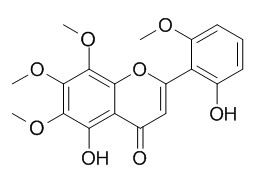Skullcapflavone II
Skullcapflavone II is a flavonoid derived from Scutellaria baicalensis, a widely used herbal medicine in anti-inflammatory and anticancer therapy in Korea. Skullcapflavone II may have therapeutic potential for the treatment of allergic asthma.
Inquire / Order:
manager@chemfaces.com
Technical Inquiries:
service@chemfaces.com
Tel:
+86-27-84237783
Fax:
+86-27-84254680
Address:
1 Building, No. 83, CheCheng Rd., Wuhan Economic and Technological Development Zone, Wuhan, Hubei 430056, PRC
Providing storage is as stated on the product vial and the vial is kept tightly sealed, the product can be stored for up to
24 months(2-8C).
Wherever possible, you should prepare and use solutions on the same day. However, if you need to make up stock solutions in advance, we recommend that you store the solution as aliquots in tightly sealed vials at -20C. Generally, these will be useable for up to two weeks. Before use, and prior to opening the vial we recommend that you allow your product to equilibrate to room temperature for at least 1 hour.
Need more advice on solubility, usage and handling? Please email to: service@chemfaces.com
The packaging of the product may have turned upside down during transportation, resulting in the natural compounds adhering to the neck or cap of the vial. take the vial out of its packaging and gently shake to let the compounds fall to the bottom of the vial. for liquid products, centrifuge at 200-500 RPM to gather the liquid at the bottom of the vial. try to avoid loss or contamination during handling.
Int Immunopharmacol.2022, 106:108603.
Current Analytical Chemistry2024, 20(8):599-610.
Cancer Lett. 2023, 18:216584.
Clin Exp Pharmacol Physiol.2015, 42(11):1189-97
Chemistry of Vegetable Raw Materials2019, 3:119-127
J Ginseng Res.2022, 46(1):104-114.
J Biomol Struct Dyn.2023, 1-21.
Int J Mol Sci.2020, 21(7):2530.
Bull. Pharm. Sci., Assiut University2020, 43(2):149-155.
Korean. J. Pestic. Sci.2024, 28(3):241-248.
Related and Featured Products
3',5,5',7-Tetrahydroxy-4',6-dimethoxyflavone
Catalog No: CFN99369
CAS No: 125537-92-0
Price: Inquiry(manager@chemfaces.com)
5,7,3'-Trihydroxy-6,4',5'-trimethoxyflavone
Catalog No: CFN90939
CAS No: 78417-26-2
Price: Inquiry(manager@chemfaces.com)
3'-Hydroxy-5,7,4',5'-Tetramethoxyflavone
Catalog No: CFN95397
CAS No: 29976-51-0
Price: $318/5mg
Tricetin
Catalog No: CFN70392
CAS No: 520-31-0
Price: $118/10mg
Tricin
Catalog No: CFN98841
CAS No: 520-32-1
Price: $258/10mg
Salcolin A
Catalog No: CFN95965
CAS No: 1977557-69-9
Price: $318/5mg
Salcolin B
Catalog No: CFN95966
CAS No: 369390-52-3
Price: $318/5mg
Tricin 4'-O-(erythro-beta-guaiacylglyceryl)ether
Catalog No: CFN95973
CAS No: 1292294-32-6
Price: $318/5mg
Tricin 4'-O-(threo-beta-guaiacylglyceryl)ether
Catalog No: CFN95993
CAS No: 369390-51-2
Price: $318/5mg
4',5-Dihydroxy-3',5',6,7-tetramethoxyflavone
Catalog No: CFN97322
CAS No: 83133-17-9
Price: Inquiry(manager@chemfaces.com)
FASEB J . 2019 Feb;33(2):2026-2036.
Skullcapflavone II inhibits osteoclastogenesis by regulating reactive oxygen species and attenuates the survival and resorption function of osteoclasts by modulating integrin signaling[Pubmed:
30216110]
Abstract
Many bone diseases, such as osteoporosis and rheumatoid arthritis, are attributed to an increase in osteoclast number or activity; therefore, control of osteoclasts has significant clinical implications. This study shows how Skullcapflavone II (SFII), a flavonoid with anti-inflammatory activity, regulates osteoclast differentiation, survival, and function. SFII inhibited osteoclastogenesis with decreased activation of MAPKs, Src, and cAMP response element-binding protein (CREB), which have been known to be redox sensitive. SFII decreased reactive oxygen species by scavenging them or activating nuclear factor-erythroid 2-related factor 2 (Nrf2), and its effects were partially reversed by hydrogen peroxide cotreatment or Nrf2 deficiency. In addition, SFII attenuated survival, migration, and bone resorption, with a decrease in the expression of integrin β3, Src, and p130 Crk-associated substrate, and the activation of RhoA and Rac1 in differentiated osteoclasts. Furthermore, SFII inhibited osteoclast formation and bone loss in an inflammation- or ovariectomy-induced osteolytic mouse model. These findings suggest that SFII inhibits osteoclastogenesis through redox regulation of MAPKs, Src, and CREB and attenuates the survival and resorption function by modulating the integrin pathway in osteoclasts. SFII has therapeutic potential in the treatment and prevention of bone diseases caused by excessive osteoclast activity.-Lee, J., Son, H. S., Lee, H. I., Lee, G.-R., Jo, Y.-J., Hong, S.-E., Kim, N., Kwon, M., Kim, N. Y., Kim, H. J., Lee, Y. J., Seo, E. K., Jeong, W. Skullcapflavone II inhibits osteoclastogenesis by regulating reactive oxygen species and attenuates the survival and resorption function of osteoclasts by modulating integrin signaling.
Int Immunopharmacol. 2012 Apr;12(4):666-74.
Skullcapflavone II inhibits ovalbumin-induced airway inflammation in a mouse model of asthma.[Pubmed:
22314230]
Skullcapflavone II is a flavonoid derived from Scutellaria baicalensis, a widely used herbal medicine in anti-inflammatory and anticancer therapy in Korea. Skullcapflavone II antagonized the bradykinin receptor more potently than any of the other flavonoids derived from this plant.
METHODS AND RESULTS:
Here, we were investigated its therapeutic effects in a mouse model of ovalbumin (OVA)-induced allergic asthma. Administration of Skullcapflavone II significantly reduced airway hyperresponsiveness (AHR), airway eosinophilia, Th2 cytokine production, and increased transforming growth factor-β1 (TGF-β1) levels in bronchoalveolarlavage (BAL) fluids and lungs from OVA-sensitized and -challenged mice. Skullcapflavone II administration also significantly suppressed subepithelial collagen deposition and goblet cell hyperplasia, elevated Smad7 expression and suppressed pSmad2/3 levels.
CONCLUSIONS:
Collectively, these findings indicate that Skullcapflavone II, a potential bradykinin antagonist, reduced the major pathophysiological features of allergic asthma, at least in part by acting on TGF-β1/Smad signaling pathways. Thus, Skullcapflavone II may have therapeutic potential for the treatment of allergic asthma.
Arch Pharm Res. 1999 Feb;22(1):18-24.
Inhibition of cyclooxygenase/lipoxygenase from human platelets by polyhydroxylated/methoxylated flavonoids isolated from medicinal plants.[Pubmed:
10071954]
Various flavonoid derivatives were previously reported to possess the inhibitory activity on cyclooxygenase/lipoxygenase. And these properties of flavonoids might contribute to their anti-inflammatory activity in vivo.
METHODS AND RESULTS:
In this study, several polyhydroxylated/methoxylated flavonoid derivatives such as oroxylin A, wogonin, Skullcapflavone II, tectorigenin and iristectorigenin A were isolated from the medicinal plants. These compounds were evaluated for their inhibitory effects on cyclooxygenase/lipoxygenase from the homogenate of human platelets in vitro. It was found that isoflavones including daidzein and tectorigenin possessed the inhibitory activity on cyclooxygenase, although the potency of inhibition was far less than that of indomethacin. In addition, oroxylin A, baicalein and wogonin inhibited 12-lipoxygenase activity without affecting cyclooxygenase, which suggested that 5,6,7- or 5,7,8-trisubstitutions of A-ring of flavone gave favorable results.
CONCLUSIONS:
The IC50 values of oroxylin A and NDGA against 12-lipoxygenase were found to be 100 and 1.5 microM, respectively.



